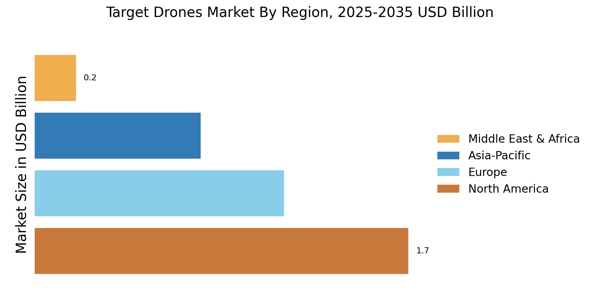Increasing Military Expenditure
The Target Drones Market is experiencing a notable surge due to the increasing military expenditure across various nations. Governments are allocating substantial budgets to enhance their defense capabilities, which includes the procurement of advanced target drones for training and operational purposes. In 2025, military spending is projected to reach unprecedented levels, with estimates suggesting a growth rate of approximately 3.5% annually. This trend indicates a robust demand for target drones, as they play a crucial role in simulating real-world combat scenarios, thereby improving the effectiveness of military training programs. The emphasis on modernizing defense systems further propels the Target Drones Market, as nations seek to maintain a competitive edge in military technology.
Expansion of Unmanned Aerial Systems
The expansion of unmanned aerial systems (UAS) is a pivotal driver for the Target Drones Market. As the adoption of UAS continues to rise across various sectors, including military, law enforcement, and commercial applications, the demand for target drones is expected to follow suit. The versatility of target drones in providing realistic training and operational support is becoming increasingly recognized. Market analysis suggests that the UAS segment is likely to grow at a compound annual growth rate of approximately 5% over the next few years. This expansion not only reflects the growing acceptance of drone technology but also highlights the critical role that target drones play in enhancing the capabilities of unmanned systems.
Rising Focus on Training and Simulation
The Target Drones Market is significantly influenced by the rising focus on training and simulation within military and defense sectors. As armed forces strive to enhance their operational readiness, the demand for realistic training environments has escalated. Target drones serve as essential tools for live-fire exercises, allowing personnel to practice targeting and engagement in a controlled setting. The market data indicates that the training segment is expected to account for a substantial share of the overall target drones market, with projections suggesting a growth rate of around 4% annually. This increasing emphasis on effective training methodologies underscores the importance of target drones in preparing military personnel for real combat situations.
Emerging Applications in Civilian Sectors
Emerging applications in civilian sectors are contributing to the growth of the Target Drones Market. Industries such as agriculture, infrastructure inspection, and disaster management are beginning to recognize the utility of target drones for various purposes, including surveillance and monitoring. The versatility of these drones allows for their adaptation to different operational needs, which is likely to drive demand in non-military applications. Market forecasts indicate that the civilian segment could account for a significant portion of the target drones market, with an anticipated growth rate of around 3% annually. This diversification into civilian applications not only broadens the market scope but also enhances the overall relevance of target drones in contemporary society.
Technological Innovations in Drone Design
Technological innovations in drone design are driving the evolution of the Target Drones Market. Advancements in materials, propulsion systems, and avionics are leading to the development of more efficient and capable target drones. These innovations not only enhance performance but also improve the operational lifespan of drones, making them more appealing to military and commercial users alike. The integration of artificial intelligence and automation is also transforming the capabilities of target drones, allowing for more sophisticated training scenarios. As a result, the market is witnessing a shift towards high-tech solutions that cater to the evolving needs of defense forces, thereby fostering growth in the Target Drones Market.


















Leave a Comment